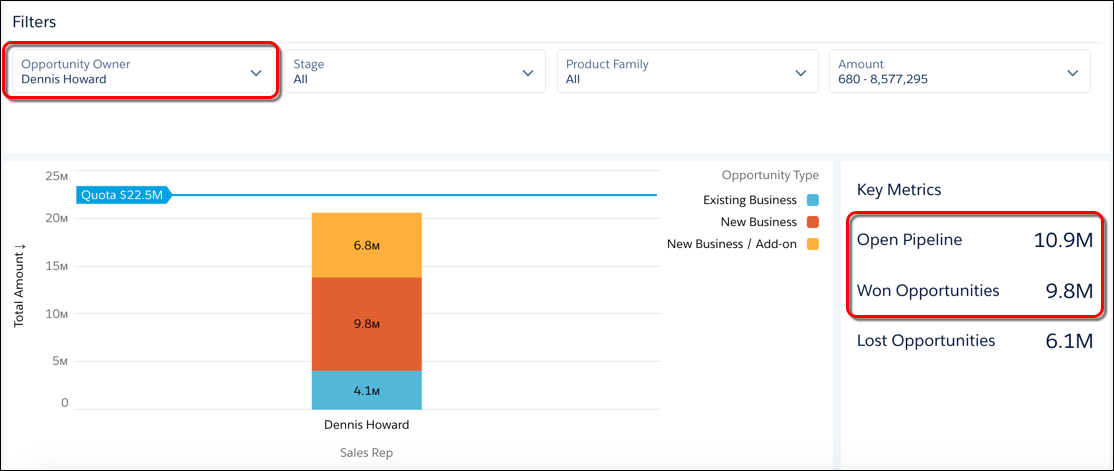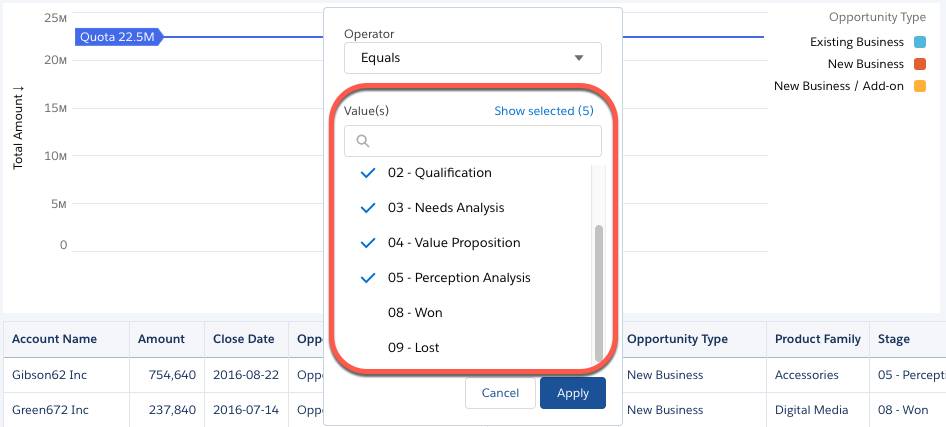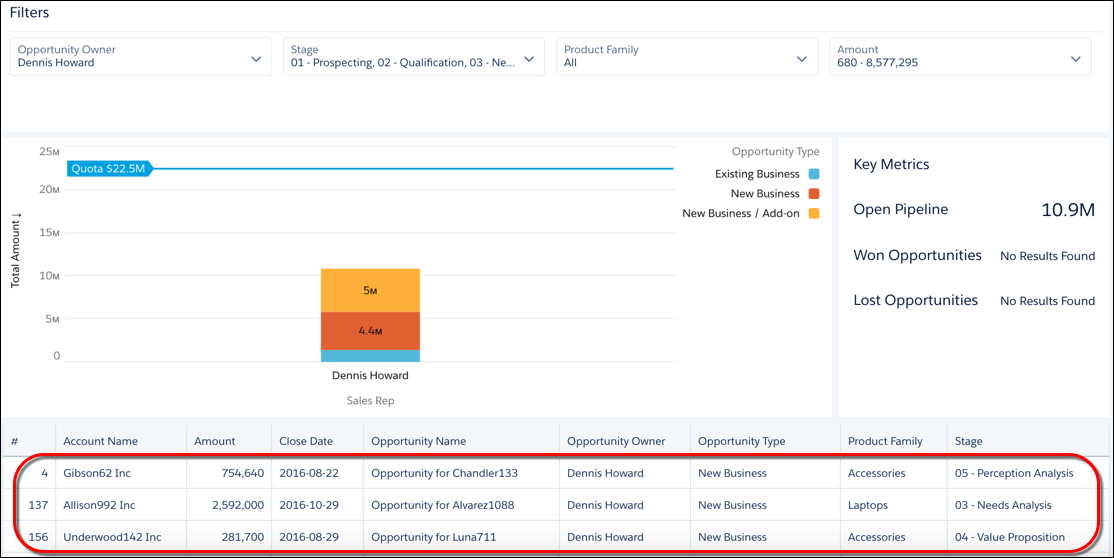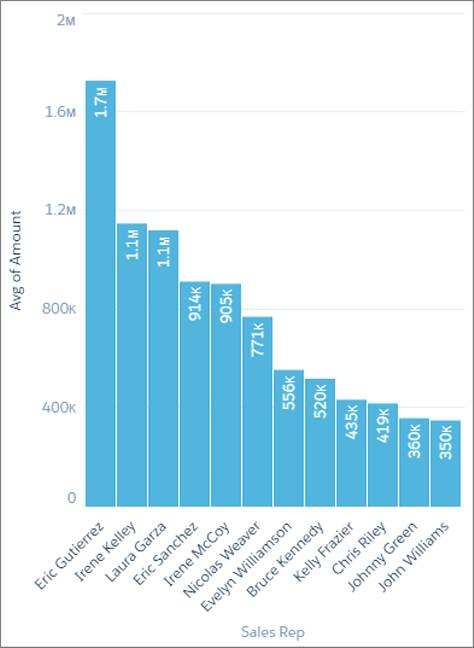Make Dashboard Widgets Interactive
Learning Objectives
Widget Interactivity, the Power of Analytics Dashboards
In the previous unit, you created global filters that let Laura and other users filter the dashboard results by rep, stage, product family, and amount. In this unit, we’ll explore how to use those filters to answer different questions. We’ll also look at ways to customize the default interaction among widgets to create an even better, dynamic experience for the sales team.
Before we jump into that, let’s step back and learn about the different ways to make dashboard widgets interact with each other. Check out this video.
OK. Back to work. Now it’s time to see the real power of Analytics dashboards. Let’s look at how dashboard interactivity can help Laura help her reps.
Monitor Sales Performance from Different Angles
Over the next sections, we’ll look at how you can use global filters to answer additional questions not answered by the initial dashboard results.
One of Laura’s initial requests was to know which reps don’t have enough pipeline to make quota. Based on the chart, Dennis Howard is the only one—his opportunities are below the quota line.
- Click the Preview button.
- To filter the dashboard results on Dennis, select Dennis Howard in the Opportunity Owner global filter and click Apply.

- Close his existing deals.
- Build his sales pipeline with more deals.
Let’s see how we can use the dashboard do that.
Move Open Deals to Closed
- Verify that Dennis Howard is selected in the Opportunity Owner filter.
- To see only open opportunities, select all stages, except 08 - Won and 09 - Lost, in the Stage global filter and click Apply.
 The table and the rest of the dashboard widgets show all open opportunities owned by Dennis. Wonderful!
The table and the rest of the dashboard widgets show all open opportunities owned by Dennis. Wonderful! 
- To sort the table records in descending order based on close date, click the Close Date column header twice.

Build the Sales Pipeline
Laura has a standard two-prong approach to help reps build their pipeline. First, she helps reps generate leads for new opportunities. Second, she provides cross-sell and upsell strategies to increase the deal size of existing opportunities.
Dennis is in luck! Last month, DTC Electronics launched a new tablet product line. To break into this new market, DTC offers a 25% discount on any accessory with the purchase of a tablet. Dennis can use this marketing campaign to get new deals and cross sell. Let’s see how well Dennis is doing with this new product line.
- To clear any selections made in the dashboard and return to its initial state, click the Return to Initial view icon. Analytics clears the selections in the Opportunity Owner and Stage global filters.
- To see his deals, select Dennis Howard in the Opportunity Owner filter and click Apply.
- Now try to select Tablets in the Product Family filter.
The tablet option is missing. It’s not there because Dennis doesn’t have any opportunities for this product line. Wow. Perhaps Dennis needs some product training and sales strategies for tablets—especially since they have so much potential. Look at the average tablet deal size for other reps. Maybe Eric Gutierrez can give Dennis some tips.
With a few selections, you were able to filter the dashboard results to answer different questions. You didn’t have to build more widgets to get your answers.
Compare Reps Based on More Sales Performance Metrics
Now let’s explore the power of bindings. Bindings let you dynamically modify any part of a query—including the measures, filters, groupings, and sort order—and change the display of a widget based on a selection or the result of another query. Let’s see how Laura can use bindings to help her team succeed.
Laura’s two-prong approach to building the pipeline is great. But to be most effective, she needs to know which reps need more deals and which need bigger deal sizes. Let’s add more performance metrics to our dashboard to help Laura determine the right strategy for each rep.
The current chart compares reps based on the total value of their opportunities. But what if we add a comparison based on the number of opps to see who needs more deals? And then add another that compares average deal size to see who needs to increase the size of their existing opps?
One way to do this is to add two more charts, one for each additional metric: number of opps and average opportunity amount. But those new charts will take up a lot more real estate on our dashboard. What if, instead, Laura can choose the metric to show in the existing chart? Oh yeah. Now we’re talking!
Welcome to bindings. Using bindings, Laura can pick one of the following metrics: number of opportunities, average opportunity amount, or total opportunity amount.
You have to tinker with some JSON to create this binding. But we don’t cover that here. To see a similar example of how to implement it, check out the “Sales Performance with Selectable Measures” dashboard included in your Analytics DE org. To see more binding examples and learn how to build them, deploy the CRM Analytics Learning Adventure app on your org. It contains lots of great examples.
Because Laura typically looks at the total amount to see who’s meeting quota, you can show the Total Amount measure by default when the dashboard first opens. To do that, use the Pick Initial Filters option to set the initial selection for the toggle widget. 
This is just one example of what bindings can do—there’s so much more sophisticated dashboard interactivity that you can implement with it.
You just created a highly impactful dashboard, not just for Laura, but for the entire sales team. Each sales rep can filter the dashboard to see how they are performing. They can track their opportunities, monitor their pipeline, and see at a glance whether they have already met or can meet quota. Most importantly, they can monitor their progress towards qualifying for that trip!
